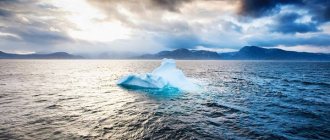Waters of the World Ocean
"The ocean is worth seeing only once,
so that you can miss him for the rest of your life.”
Patrick Ness
Today in class we:
· let's talk about the role of the ocean in the life of the Earth, the origin and properties of its waters;
· learn what is meant by the water masses of the World Ocean.
Before we begin to study these questions, let's remember with you : What is the World Ocean?!
World Ocean
is
a continuous water shell of the Earth
surrounding continents and islands, which contains dissolved salts and minerals.
It covers about 71% of the entire earth's surface
.
All waters of the World Ocean are united and interconnected.
It is this relationship that carries out
the World Water Cycle in nature
.
The fact is that under the influence of sunlight, water in the ocean evaporates and rises, forming clouds
.
Thanks to the movement of air masses, water from the clouds falls onto land in the form of precipitation
, while replenishing groundwater and surface waters, which carry them back to the World Ocean.
Then the cycle repeats
. This is how the world water cycle occurs in nature.
What is its significance for life on Earth?! The importance of the World Water Cycle for life on Earth is very great. It is this process that determines many features of the Earth’s nature:
namely soil, flora and fauna, climate.
It also unites all the shells of the Earth:
the atmosphere, hydrosphere, lithosphere, biosphere.
for human economic activity is also great.
.
It is a source of various seafood, minerals, energy
and, finally, the most spacious road in the world, connecting countries and continents.
Intensive study of the World Ocean began in the second half of the 20th century. The main method of exploring the ocean depths was the method of echolocation
.
It was thanks to this method that many scientists were able to develop more detailed maps of the depths of the oceans
.
underwater waterfalls in the ocean
!
Moreover, some of them are much more massive than those on land. Today, only 7 underwater waterfalls are known. The reason for their occurrence is the uneven distribution of temperature and salinity of water
in different parts of the ocean, as well as the
complex structure of the seabed topography
.
The largest known underwater waterfall
was discovered at the bottom
of the Denmark Strait
, separating Greenland and Iceland.
Its height is about 4 km
.
Since ancient times, humanity has been concerned with the issue of exploring the World Ocean.
.
Today, thanks to scientific and technological progress, it has been possible to detect eddies in the ocean waters, underwater currents, and prove the existence of life at great depths.
In addition, it was thanks to the study of the bottom of the World Ocean that it was possible to create a theory of the movement of lithospheric plates.
How did water appear on Earth?
Scientists have not yet put forward a final version.
Some are of the opinion that water appeared on Earth as a result of the fall of meteorites from ice, dust and gases.
Others believe that
water was released from magma
, falling onto the surface of the planet during volcanic eruptions.
Still others suggest that water appeared immediately during the formation of the lithosphere from the upper mantle
.
What are the main properties of ocean water?
The main properties of the waters of the World Ocean include
salinity and water temperature
. As a rule, many different chemical elements are dissolved in sea water: sodium, chlorine, magnesium, calcium and even gold.
The main reason that distinguishes the waters of the World Ocean from the waters of land is increased salinity
.
The salinity of ocean waters is not the same everywhere. First of all, it depends on the ratio of precipitation and evaporation
, which varies depending on latitude. For example, the salinity of waters near the equator is 34 ppm, in the tropics - 36 ppm, but in the region of temperate and polar latitudes - 33 ppm. Obviously, salinity is higher where evaporation exceeds the amount of precipitation, where river flow is low, and where ice does not melt.
Salinity
The saltiest ocean in the world is the Atlantic.
Despite the fact that it collects a large amount of fresh water, the percentage of salt here is 35.4 ppm. The Atlantic Ocean is very interesting. In almost any place, the percentage of salt is the same. This feature is unique to him alone.
Another important property of ocean waters is temperature.
.
The fact is that water heats up much more slowly than land
.
The sun's rays warm up only the top layer of ocean water, then mixing, the water gives off its heat to the lower layers. Thus, the temperature of ocean water varies with both latitude and depth. At a depth of one kilometer, the temperature does not exceed 3-4 degrees
.
The warmest oceans in the world are the Pacific and Indian.
The Arctic Ocean is considered the coldest, and it is also the smallest.
Ice formation depends on the temperature of ocean waters
.
Ice mainly forms only in polar and subpolar latitudes
, under conditions of a long winter period.
Ice in the World Ocean
Based on their mobility, the oceans are divided into stationary and drifting ice. Fixed ice
- This is a continuous ice cover frozen to the shore or to the bottom in shallow waters.
These glaciers are formed by large accumulations of snow, which gradually compact and turn into ice. The most powerful glaciers formed at the poles, and are also called polar caps
.
Fixed ice
Drifting ice moves under the influence of winds and currents
.
The most dangerous of them are icebergs
. This is nothing more than huge pieces of ice floating freely in the ocean. In the Northern Hemisphere, icebergs most often break off from the glaciers of Greenland, in the Southern Hemisphere - from Antarctica.
Interesting fact: immediately after the sinking of the Titanic on April 14, 1912, due to a collision with an iceberg, the major maritime powers signed an agreement to create the International Ice Patrol
. As a result, collisions between the ship and icebergs practically ceased.
Today, the idea of transporting icebergs to arid places on the planet
. After all, first of all, an iceberg is a floating supply of fresh water.
Large volumes of water that formed in certain parts of the ocean and differ in temperature, salinity, density, transparency, and other properties are called water masses
.
Depending on the depth, water masses are divided into surface
(formed under the influence of the atmosphere and the influx of fresh water from the mainland to a depth of 200-250 m);
intermediate
(having a lower limit within 500-1000 m);
deep
(the lower limit of which is determined within 1200-5000 m) and
bottom water masses
(occupying the zone of the World Ocean below 5000 m).
Depending on the place of formation, water masses are divided into equatorial, tropical, temperate and polar water masses
.
It is worth noting that water masses actively interact with the atmosphere:
give it heat and moisture, absorb carbon dioxide, and release oxygen.
Let's summarize the lesson.
World Ocean
is a continuous water shell of the Earth surrounding continents and islands, which contains dissolved salts and minerals.
All waters of the World Ocean are united and interconnected.
To the main properties of the waters of the World Ocean
refers to salinity and water temperature.
Large volumes of water that formed in certain parts of the ocean and differ in temperature, salinity, density, transparency, and other properties are called water masses
.
Outline of a geography lesson on the topic “Waters of the World Ocean”
I suggest you remember the properties of water and fill out the table. (Time 3 minutes).
Time is up, now let's test ourselves!
Properties of water:
- Water is odorless, colorless and tasteless.
- Water is the only substance known to us that occurs naturally on the surface of the Earth in solid, liquid and gaseous states.
- Water has the ability to absorb a large amount of heat and heat up relatively little. In addition, water has a very high latent heat of fusion (80 cal/g) and evaporation (540 cal/g), meaning it absorbs a significant amount of additional heat while maintaining a constant temperature during freezing and boiling.
- Water is a universal solvent. It dissolves more salts and other substances than any other substance.
- Water is very difficult to oxidize, burn, or decompose into its constituent parts. Water is a chemically resistant substance.
- Water has the unique ability to expand when it freezes, causing ice to float on water that remains in the liquid phase.
- Distilled water conducts electricity very poorly, but even very small additions of salts turn it into a very good conductor.
- Check yourself!
– What is the composition of water?
- That's right, fresh and salty. Let's compare their properties.
- Well done!
– What is the composition of the water in the World Ocean? ( Marine)
– What do you think are the main properties of the waters of the World Ocean that influence the development of life on Earth?
– That’s right, water temperature and salinity!
– The unique property of water as a substance is its ability to heat up slowly and cool down slowly. Therefore, the ocean accumulates a huge amount of heat and serves as a temperature regulator on land.
– Consider the map “Average annual temperature of the waters of the World Ocean.”
– What features of the temperature distribution of surface waters do you see?
– That’s right, the temperature of the surface waters of the World Ocean is unevenly distributed.
In the open ocean, water temperature varies from – 2° to + 30°C. Surface temperatures in the Gulf during the summer months exceed 33°C, and in shallow waters off the coast can reach 36°C.
The coldest water is in the Weddell Sea, in Antarctica.
– What do you think determines the temperature of the waters of the World Ocean?
– The main reason is climate. The sun heats only the surface of the ocean; this heat is transferred into the thickness of the ocean by mixing and currents.
The average temperature of the surface layer of the World Ocean is +17.5°C; with depth the temperature drops and does not exceed 2°C deeper than 1 km.
In the polar regions it drops to 0°C and below, and in equatorial latitudes the water heats up to 27-28°C.
The highest surface water temperature is in the Pacific Ocean (+19.4°C), Indian (+17.3°C), Atlantic (+16.5°C) oceans, the lowest water temperature is in the Arctic Ocean (-1 °C).
The average water temperature of the World Ocean is 3.51°C.
Sea water freezes at a lower temperature: -1.9°C. The higher the salinity of the water, the lower the freezing point. Ice constantly covers the central part of the Arctic Ocean and surrounds Antarctica. In winter, the area covered with ice expands; in summer, on the contrary, it shrinks.
– Find on the map of the oceans in the atlas the winter boundary of the distribution of floating ice in the northern and southern hemispheres. Determine to what latitude it reaches in each hemisphere.
– When diving into the depths of the ocean, a decrease in water temperature is observed everywhere, except in the polar regions. In the upper layer of water at a depth of 300-500 m, the temperature drops sharply, below it it decreases smoothly. At depths of 3000-4000 m more, the water temperature fluctuates between +2°C and -1°C.
– Water is an excellent solvent. Rain breaks down rocks on land, and small debris, gravel, sand and dissolved chemicals are carried by streams into rivers, which carry them to the seas and oceans. The water heated by the sun evaporates, and the brought sediments and chemicals accumulate in the seas and oceans. Therefore, almost all substances known on Earth are dissolved in sea water. Sea water tastes bitter and salty. This is due to the composition of dissolved salts. Salty taste of sea water is given by table salt, bitterish - Most of all salts in it are chlorides (89%) and sulfates (11%), giving the water a bitter-salty taste.
– Sea water is a special type of natural water. The most important characteristic of sea water is salinity. The salinity of sea water is the content in grams of all minerals dissolved in 1 liter of sea water. Salinity is expressed in g/l, that is, in thousandths - ppm and is designated S (%o). The average salinity of the World Ocean is 35%o, that is, every liter of water contains 35 grams of minerals.
– How is water salinity distributed in the World Ocean?
– Consider the map of the salinity of the waters of the World Ocean, draw conclusions about the distribution of salinity of waters in the World Ocean.
– What do you think determines the salinity of water?
Let's do laboratory work.
Experience 1
. Let's take two vessels, pour the same volume of water and the same volume of salt, mix everything well. We will add fresh water to one of the vessels after a certain period of time.
– What do you think will happen, for example, in a week?
– What conclusions can be drawn about what determines the salinity of water?
– Where does fresh water come from in the World Ocean?
– The salinity of the waters of the World Ocean depends on the influx of fresh water from land (river runoff), atmospheric precipitation and melting ice.
- Complete the sentences:
The _____________ precipitation falls, the _________ salinity of the waters of the World Ocean.
The _____________ river flow into the World Ocean, the _________ its salinity.
Experience 2.
Let's take two vessels, pour the same volume of water and the same volume of salt, mix everything well. We will heat one of the vessels.
– What will happen in 10 minutes?
– In which vessel will the water be saltier?
– What conclusions can be drawn about what determines the salinity of water? The salinity of the waters of the World Ocean depends on temperature and evaporation from its surface
.
- Complete the sentences:
The _____________ temperature, the _________ evaporation of the waters of the World Ocean.
The _____________ evaporation, the _________ salinity of the waters of the World Ocean
Let's summarize:
– Where there is more precipitation and evaporation is low, salinity is lower, and it is also lowered by river waters and melting ice waters.
– Towards high latitudes, salinity decreases; it is also low in equatorial regions, where there is a lot of precipitation and evaporation is somewhat reduced, and in tropical latitudes salinity is increased.
This is interesting
. If all the salts dissolved in the waters of the World Ocean are evaporated and evenly distributed over the surface of the Earth, then our planet will be covered with a layer of salt 45 meters thick.
– The average salinity of the Atlantic Ocean is 35.4%o, its internal Baltic Sea is 10-12%o (in the bays 2-6%o). Why do you think?
– This is explained by the fact that in the temperate climate zone, where the Baltic Sea is located, there is a large amount of precipitation and, in addition, many rivers carrying fresh water flow into the sea.
– The average salinity of the Indian Ocean is 34.8%. The salinity of the Red Sea is 40-42% - the saltiest sea on Earth. Why?
– Little fresh water enters the sea, and evaporation is significant, then its salinity turns out to be greater than the salinity of the ocean to which the sea belongs.
– The saltiest lake-sea in the world is the Dead Sea (about 300%).
– Average salinity of the oceans: Pacific Ocean – 34.6%o, Atlantic Ocean – 37.5%o, Indian Ocean – 34.8%o, Arctic Ocean – 32%o.
– Which ocean is the saltiest? Why?
III. Reinforcing the material covered
– Reasons that determine the properties of the waters of the World Ocean.
– Solve problems:
1. Calculate how much salt can be obtained from 1 ton of Red Sea water, knowing that the sea’s salinity is 42%.
2. How many grams of salt are contained in 1 kg of sea water, if 7 tons of water yield 280 kg of salt?
3. It is known that polar explorers do not care about the supply of fresh water necessary for cooking or drinking. They use ice, which is formed from bitterly salty sea water. Why does water become fresh if it comes from melted sea ice?
– Reveal the reasons on which the basic properties of oceanic and sea waters in different parts of the World Ocean depend.
IV. Homework:
Read the paragraph “Some properties of the waters of the World Ocean” and fill out the table:





